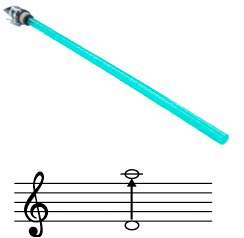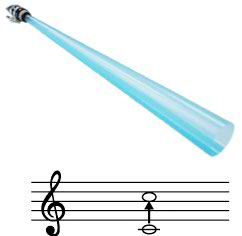The Structure of the Clarinet
[Experiment]comparing the clarinet and the recorder
Performing a sound experiment
Try rolling up a transparent sheet in various ways and attaching a clarinet mouthpiece. What sounds does this produce?
Is the tube of a clarinet dead straight? The tube appears to get slightly wider, so try making two different tubes-one that is straight and one that gets wider towards the end.
Experiment steps
- Find some polypropylene sheets.
- Roll up the sheets to make a straight tube and a conical tube of equal length.
- Fit the tubes to the mouthpiece of the clarinet and attach the reed.
- Blow into the tubes, varying the strength of your breath.
Results of the experiment
Straight tube

Flared tube

*As this was an experiment, the recorded pitches differed from the correct notes.
The initial notes are the lowest notes produced with each tube, and these are followed by the notes produced when the tubes are blown a little more strongly. There is a surprising difference in the manner in which each tube's note rises.
The note from the flared tube rises by one octave, from C to high C. The note from the straight tube rises from D to high A-a span of more than one and a half octaves. The fact that the rise in the note on the straight tube is the same as the rise in the note on a clarinet (from C to high G) would seem to indicate that the clarinet is similar to the straight tube.
The tube of the clarinet is certainly straight for the most part. Although it does have a slightly conical flare in the lower section towards the bell, the clarinet is essentially a straight cylindrical tube. This unique tube shape enables the note to be changed by one-and-a-half octaves (or 12 tones in technical parlance). It could also probably be said that this tube makes it easy to produce odd harmonics.
A conical tube that flares at the end is more akin to an instrument such as a saxophone or horn.
Musical Instrument Guide:Clarinet Contents
Structure
How the Instrument is Made
Choosing an Instrument
Trivia
- "I Broke My Clarinet" is a French folk song
- Inspiring composers
- In Italy, a single B♭ clarinet
- At one time, most clarinets were made of boxwood
- In vogue in the 1900s-the metal clarinet
- A transparent clarinet?
- Famous clarinet works: concertos
- Famous clarinet works: chamber music
- What is the relationship between hertz and cents?
